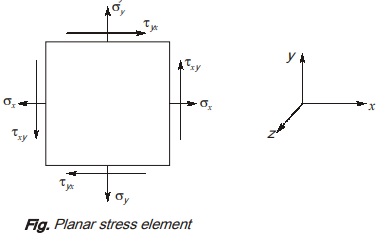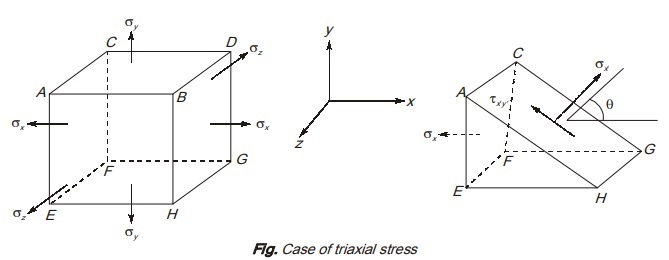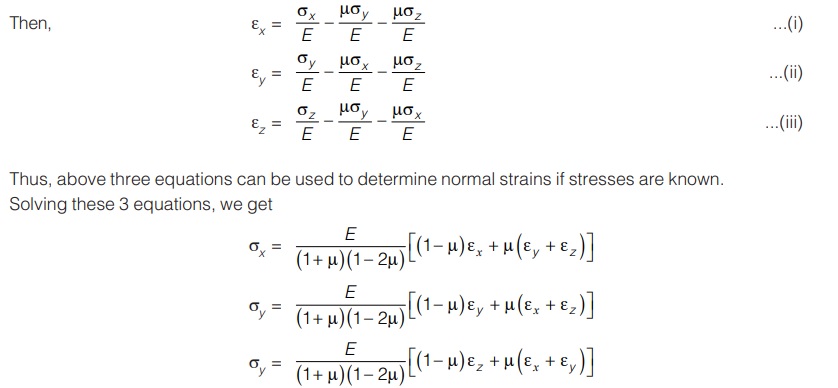Hooke Law for Plane Stress
Consider a plane stress element is shown in figure.
In this stress element
σz = 0
σyz = 0
τxz = 0
Let the normal strains in x, y and z directions are represented by εx, εy, εz respectively.
Shear strain in x-y plane, x-z plane, y-z plane are represented by φxy, φxz and φyz respectively.
As discussed in earlier chapters,
εx = σx/E – µσy/E …..(i)
εy = σy/E – µσx/E …..(ii)
εz = -µσy/E – -µσz/E …..(iii)
Normal strains in x, y and z directions can be found
out by using these equations if stresses are known.
Also, φxy = τxy/G
Note that axial stress σx and σy does not produce shear strain.
Solving (i) and (ii), we get

All the above 7 equations are known as Hooke’s law for plane stress.
In these equation,
E = Young’s modulus of elasticity
G = Shear modulus
µ = Poisson’s ratio
Volume Change
As discussed in earlier chapter
Volume strain for a body, εv = σx + σy + σz/E (1-2µ )
But for plane stress, σz = 0
So, dilatation or volumetric strain, εv = σx + σy /E (1-2µ )
For uniaxial stress, σy = σz = 0
So, volumetric strain, εv = σx /E (1-2µ )
Triaxial stress
Consider a stress element as shown in figure subjected to normal stresses σx, σy and σz only. As the stress element is subjected to axial stresses in three mutually perpendicular direction, it is said to be a case of triaxial stress.

It is to be noted that as there are only normal stress on stress element and no shear stress, hence these normal stresses are principal stresses for the element.
Cut an inclined plane parallel to z-axis through element and normal to plane parallel to xy plane as shown in figure a(ii).
On face ACGH, only stresses are normal stress σx′ and shear stress τx′y′ which can be determined by using transformation equations. Note that these are independent of stress σz.
Thus, in triaxial state also, transformation equations or Mohr’s circle can be used to find normal and shear stress on an inclined plane.
Similar analysis can be done if planes parallel to x and y axis are cut.
Maximum Shear Stress
As studied earlier, plane of maximum shear stress occur at 45° to principal planes.
Hence, if we rotate the stress element about z-axis by 45°, the maximum value of shear stress,
(τmax)z = ± σx – σy/2 ——(i)
(τmax)y = ± σx – σz/2 ——(ii)
(τmax)x = ± σy – σz/2 ——(iii)
Absolute maximum shear stress is largest of shear stress obtained from above 3 equations.
Hooke’s law for triaxial stress
Let the strains produced by normal stresses on stress element in figure are εx,εy ,εz in x, y and z-axis respectively.

Volume change
As discussed in earlier chapters
Volumetric strains, εv = σx + σy+ σz /E (1 – 2µ)
Special case I: Spherical stress
A spherical stress element is a special type of triaxial stress in which
σx = σy = σz = σo
In this type of stress element, any plane inclined at an angle θ cut through the element will only have normal stress
σo and no shear stress.
The normal strain in all the direction is same. So, normal strain, ε = σ0 /E (1 – 2µ)
Volumetric strains, εv = σx + σy+ σz /E (1 – 2µ)
σx = σy = σz = σo
ε = 3σ0 /E (1 – 2µ) = 3ε0
k = E / 3(1 – 2µ)
k = Bulk modulus of elasticity = σo/εv
<< Previous | Next >>
Must Read: What is Strength of Material?

